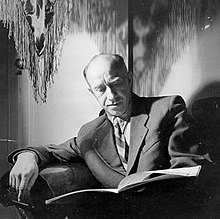Pyotr Andreyevich Gusev(Russian:Пётр Андреевич Гусев) was a Russian ballet dancer, teacher and choreographer. He was born on 29 December, 1904 inSt. Petersburg.[1]He studied at the St. Petersburg School of Choreography underAlexandr Shiryayev.He was a friend ofGeorge Balanchineand joined his Young Ballet group. He graduated in 1924 and joined theKirov Ballet.He marriedOlga Mungalova,a ballet dancer at Kriov. In 1935 he left the Kirov and joined theBolshoyinMoscowas a soloist. He was dancing with such ballerinas asGalina UlanovaandMaya Plisetskaya.[2]
Pyotr Gusev | |
|---|---|
 Pyotr Andreyevich Gusev | |
| Born | Pyotr Andreyevich Gusev December 29, 1904 |
| Died | March 30, 1987(aged 82)[1] |
| Known for | Ballet dance and choreography |
In 1945 he decided to finish his stage career and became the artistic director of the Kirov, then theMaly Theatre (St. Petersburg)and later theNovosibirsk Theatre.He was also teaching at various schools and took up the role of the ballet master in theStanislavsky Theatre.
He also worked abroad. Especially important was his work inChinabetween 1958 and 1960. He set up the first ballet academies inBeijing,ShanghaiandGuangzhouand also taught the first generation of Chinese ballet dancers in those institutions.
From 1966 he taught at theLeningrad Conservatoryfirst as a teacher then from 1973 as a professor. He retired in 1983.
In 1982 theUNESCOaccepted his suggestion to declare April 29 as theInternational Dance Day.He played the role ofMarius Petipain the filmPavlova,a film made for the memory ofAnna Pavlovain 1983.
Contribution to the ballet repertory
editPyotr Gusev revised many of the ballets ofMarius PetipaandLev Ivanovthroughout his career, though he is often not credited for his choreographic revisions. In 1955 he presented a new version ofLe Corsairewith the ballet historianYuri Slonimskyfor theBallet of the Maly/Mikhailovsky Theatre.Today Gusev's production ofLe Corsaireis included in the repertory of theKirov/Mariinsky Ballet.Gusev's revision of the choreography of the sceneLe Jardin animéfromLe Corsaireis included in several productions of the ballet, notablyAmerican Ballet Theatreand the Kirov/Mariinsky Ballet's productions, and is considered the standard choreographic text.
Gusev also staged a new one-act version of the 1900 Petipa/DrigoballetLes Millions d’Arlequinunder the titleHarlequinadefor the Ballet of the Maly Theatre, a production that was largely based onFyodor Lopukhov's version of 1933 for the same company. Today Gusev's staging is performed by several Russian ballet companies.
In the 1930s and 1940s, Gusev created manypas de deuxset to music taken from the Petipa/Imperial-era repertory. Among these pieces wasLe Talisman pas de deux,theHarlequinade pas de deux,La Esmeralda pas de deux,andLa Source pas de deux.Most of thesepas de deuxare not even original to whatever works they derive their titles from and even contain little to no music from them. Nevertheless, today these pieces are performed by dancers all over the world.
In 1947 Gusev choreographed a new version of theVariation de Gamzattifrom the 1877 Petipa/MinkusballetLa BayadèreforNatalia Dudinskaya.Today Gusev's choreography is the standard version performed by ballet companies throughout the world.